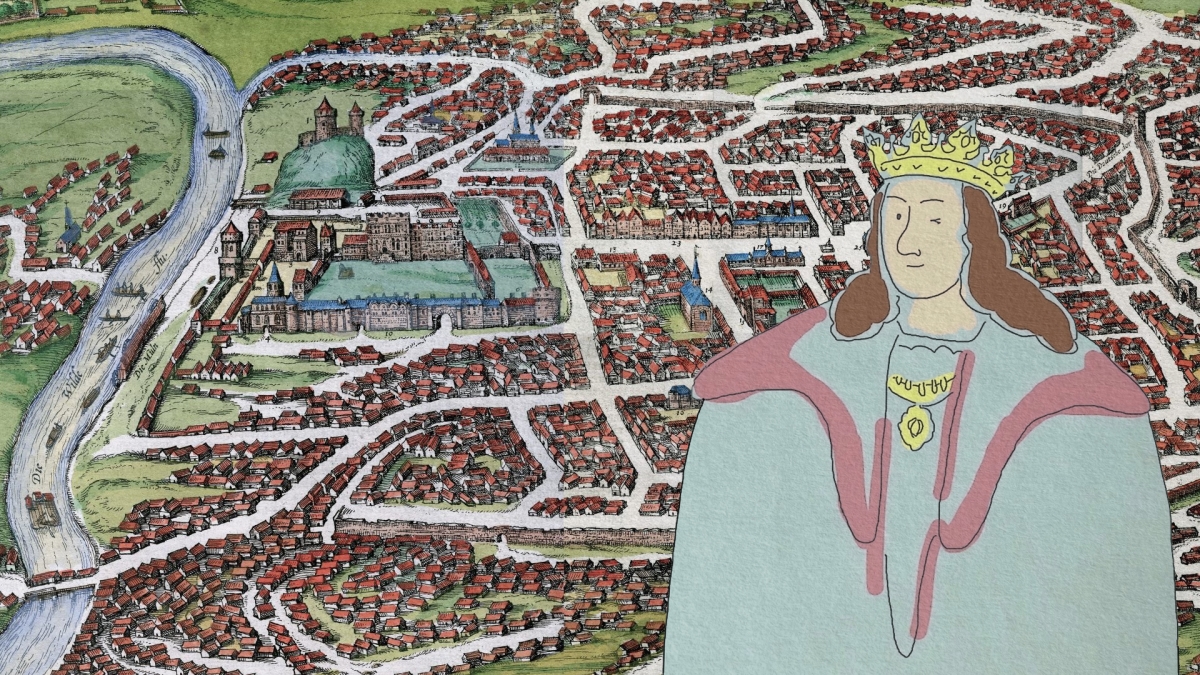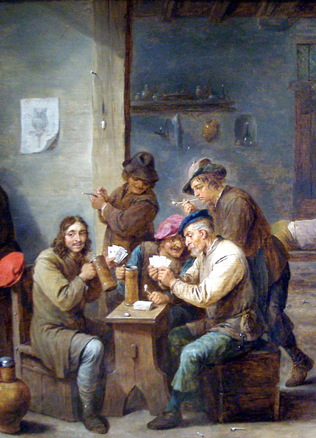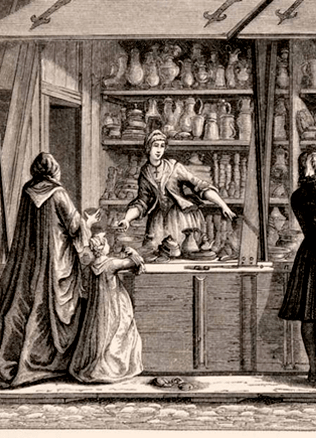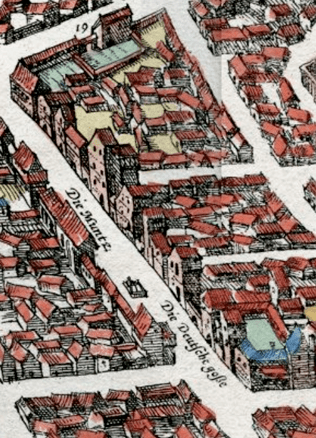The goldsmith guild established in Vilnius in 1495 was the first one in the Grand Duchy of Lithuania
Smaller or larger towns and settlements were always important centres of crafts. Craftsmen of various specialisations satisfied all the needs of the market and sometimes even the needs of more remotes towns or even foreign countries. Having reached a higher level of production, craftsmen of one or related specialisations united into professional organisations – guilds. The first guilds appeared in Western Europe in the 10th – 12th centuries, and in the 14th – 15th centuries they were developing most intensely. The main aim of such organisations was monopolisation of manufacture of products and the established realisations of goods. From this point of view Lithuania seriously lagged behind even her nearest neighbour Poland where the first guilds emerged as far back as the 13th century. Genesis of the guilds of the Grand Duchy of Lithuania was closely related to the establishment of Magdeburg law (1387) and a growing influence of western culture of crafts. Faster changes started to take place in the 15th century. In 1458, the mead fraternity of furriers was established in Vilnius, and in the second half of the 15th century more fraternities of this kind emerged. Though these fraternities were not professional organisations yet, but unifications of religious and social nature (Orthodox Believers) speeded up the appearance of the guilds. Therefore, it was in Vilnius on 23 August 1495 that the first guild of goldsmiths was founded. Soon afterwards, in the same year, the sewing guild was founded. Having remained independent, the goldsmiths lost their right to engage in their crafts in Vilnius. All in all, nine guilds, which united 16 crafts, operated in Vilnius before the Union of Lublin in 1569. All that marked mastering of usual technology of Western European towns and showed that craftsmen of high qualification worked in the capital of the Grand Duchy of Lithuania.
Goldsmiths worked for Lithuanian Dukes
It was not by chance that goldsmiths were the first to have established the guild in the Grand Duchy of Lithuania. Courts of the Grand Dukes and the ruling elite, as well as high-ranking clergy of Lithuania, became acquainted with the western culture quite early. The Rulers gladly accepted the gifts from the Masters of the Teutonic Order: different kinds of jewellery, silver or gold-filled tableware and armour, other luxury items. Until the first half of the 15th century expensive things that were necessary to the Catholic Church for the cult purposes and things used in secular life were imported into Lithuania. They were produced in the strong goldsmith centres: in Krakow, Gdansk, Konigsberg, Riga.
Due to a great demand for jewellery goods, with the widening strata of society could afford such articles, increasing individual goldsmiths most likely started to move to Vilnius from the afore-mentioned centres.
The first craftsmen of this kind who worked for the Dukes of Lithuania were earliest mentioned at the end of the 13th century: the account book of Riga of 1292 mentions the goldsmith Jacob who manufactured for one Duke of Lithuania. The goldsmiths Mark and Jan who worked in Vilnius were mentioned at the beginning of the 15th century, the latter was known as the author of a large silver monstrance manufactured for the Dominicans of Krakow. When he moved to Krakow, he became an assessor of that city. German goldsmiths Petrus Germanus, Klemens, Niklas, and Jonas who worked in Vilnius at the end of the 15th century bought plots of land and houses in this town. In 1494, the goldsmith Ignatka Lopsza accompanied Grand Duchess Elena from Moscow to Vilnius and worked in her court and the court of Alexander Jagiellon until the beginning of the 16th century. Some other craftsmen of this field Hanus, Piotr, Wincenty, and Konrad are mentioned in the account books of the Lithuanian court kept by Alexander Jagiellon in Vilnius at the end of the 15th century – the beginning of the 16th century. An increase in the number of these and other highly qualified masters in the Ruler’s court led to appearance of the goldsmith guild in Vilnius.
Pioneers of creating the guilds
The Grand Duke of Lithuania Alexander Jagiellon approved the privilege to the goldsmith guild and the Statute of the guild in Trakai in 1495. This organisation of a voluntary corporation of goldsmiths became an example to other guilds in Lithuania. The regulations of the guild were prepared on the basis of western traditions, for example, the Statute of craftsmen guild of any European town could be adapted to the goldsmiths of Vilnius. The guild most probably was established by a small group of experienced goldsmiths after they had become acquainted with practice of the activity of the guilds in Europe and managed to defend their exclusive rights. That could have been masters of high qualification, mainly foreigners who arrived from the goldsmith guilds in Poland and Germany. At the beginning of the 17th century, about 20 members belonged to Vilnius goldsmith guild.
Do You Know?
According to the 1495 Statute of the guild, he who wanted to get the name of the guild master had to produce three articles: a goblet, a seal with an etched shield and a ring with a jewel. If all that was assessed in the positive, elders of the guild showed those to the Magistracy of Vilnius, and the new master took the citizenship of the town.
Tests of new members
The 1495 Statute of the guild defined the structure of the fraternity of goldsmiths, regulated production functions and the religious activity of the members. The first Statute did not limit the number of apprentices and pupils.
It was sought to regulate competition between the masters of the guild by forbidding enticing apprentices and pupils of another master.
Pupils had to learn for at least three years. During all that time the master watched not only the pupil’s work but also his behaviour at home and punished him for offences. Once an apprentice became free and could choose the master, his work was already paid. According to the 1495 Statute of the guild, he who wanted to get the name of the guild master had to produce three articles: a goblet, a seal with an etched shield and a ring with a jewel. If all that was assessed in the positive, the elders of the guild showed the articles to the Magistracy of Vilnius and the new master took the citizenship of the town. The guild handled general affairs of the goldsmiths, managed the guild’s assets, and controlled the goldsmith guilds and the quality of the articles. Admittance of pupils, issuance of certificates to the apprentices, assigning the tasks to receive the name of a master of an apprentice, admittance of new members, trade in non-ferrous metals and hallmark testing were within its competence.
Traditions and rituals
Members of the guild were called brothers, the guild decided cases between them, and it was only in case the decisions of the guild were disobeyed that the cases had to be handed over the Magistracy of the town. The guild had its chapel, its members took part in the funerals of the goldsmiths, took care of the families of the sick or dead goldsmiths. The supreme power of the guild was the general meeting of its members. It was held four times per year and was called “the quarterly.” Participation in the general meeting was obligatory. Those who were not present or who were late, like those who did not take part in the services in the chapel, were punished by imposing monetary fines on them or by administering wax punishment. Some of the elders headed the meetings and it always started with a solemn opening of the guild chest and reading the privileges and the Statute.
The meetings were stormy.
For example, at the end of the 17th century, after Stanisław Danilowicz was elected elder, the former elder Mateusz Greiter handed over neither his duties nor the guild chest to him and stated that “he was too young and did not fit to be the senior; as long as I am in the guild, you will not prove that you can be the senior.” The goldsmith guild had distinctive symbols – the stamp of the guild, the flag, the drum and the guns. Despite the prohibition legalised in the Statute of the guild goldsmiths who did not belong to the guild continued to work in the town. In the 16th–18th centuries a fierce fight against them was waged.
The first Vilnius goldsmith guild of the Grand Duchy of Lithuania established at the end of the 15th century became a strong professional organisation. Its members were wealthy town-dwellers of Vilnius and quite often occupied positions in the government of the town.
Literature: E. Laucevičius, B. R. Vitkauskienė, Lietuvos auksakalystė XVI–XIX a., Vilnius, 2001, p. 36–128.
Raimonda Ragauskienė




